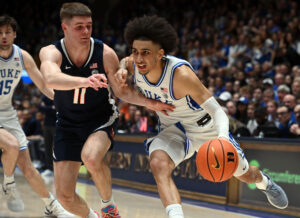On Thursday night I watched Lovie Smith throw Chicago’s already slim chances of winning a game at Lambeau field right out the window of a moving vehicle into on-coming traffic.
With eight minutes left in the 4th quarter and the Bears trailing by 20 points, Lovie Smith sent out the punt unit with the Bears at midfield. It doesn’t matter that it was 4th and 21, a punt at this point virtually ensures the Bears will not have enough time left to win the game even if they get the ball back scored two td’s followed by an on-side recovered kick and a third td. It was a classic case of a coach giving up and switching his focus towards keeping the margin of defeat low. When a coach gives up on a game how can he expect his players not to do the same?
Improbably the punt paid off when the Bears got an interception off of Aaron Rodgers and quickly turned it into a TD. The score had them down 13 points with just under 7 minutes left and all of their timeouts remaining. This left Lovie Smith with another “tough” decision, which I am certain was not even a decision in his mind. Do the Bears kick deep and try to get a quick stop or do they go for the onside kick now?
 With the way the Chicago offense had been performing on the night, the Bears needed to try an onside kick and keep the momentum riding high. If you kick deep, or if you fail to recover an onside kick, the result is the same – the defense needs to get a stop. However, going for the immediate onside kick has many benefits. Doing so with seven minutes left will allow the Bears to lineup with a regular formation and go for a surprise onside kick – even if Green Bay is half-expecting it. But the key element to onside kicking early is giving your team the ability to control the clock. If the Bears kick deep and do get a quick stop on the Packers they would be looking at having about five or six minutes left, enough time to drive the field for one, score maybe, but without a quick strike the Bears would be left with little time left on the clock and be forced to onside the ensuing kick anyways.
With the way the Chicago offense had been performing on the night, the Bears needed to try an onside kick and keep the momentum riding high. If you kick deep, or if you fail to recover an onside kick, the result is the same – the defense needs to get a stop. However, going for the immediate onside kick has many benefits. Doing so with seven minutes left will allow the Bears to lineup with a regular formation and go for a surprise onside kick – even if Green Bay is half-expecting it. But the key element to onside kicking early is giving your team the ability to control the clock. If the Bears kick deep and do get a quick stop on the Packers they would be looking at having about five or six minutes left, enough time to drive the field for one, score maybe, but without a quick strike the Bears would be left with little time left on the clock and be forced to onside the ensuing kick anyways.
An onside kick recovery, however, would allow the Bears to at least somewhat control their own end game. If the Bears were able to score quickly without burning through their timeouts then they would have options. They would have the opportunity to kick deep and use their time outs on Green Bay’s final possession, leaving themselves with enough time for one final drive. If they are unable to score quickly then they would be forced to onside kick a second time – but this would leave them in no worse of a position than kicking deep on their initial kick-off.
Needless to say the kick boomed deep and any chance the Bears had of winning went out the window with it. For shame. The Bears did get the stop they were looking for but it took all of their timeouts and there was only four minutes left on the game clock. The game was essentially over. That is to say, Lovie Smith’s plan went almost perfectly according to his plan (Green Bay picked up one first down on their possession) and the Bears still did not have a chance to win. I am unsure if Lovie Smith cared though. He had accomplished his goal of keeping the losing margin to a minimum. Time to go home after a good day’s work and re-group.
I welcome you to check out “3rd String NFL” and “Last Word Fantasy Football”.





